Elizabeth Styring Nutt - The Search for the Settings
of Four Seasonal Paintings of the North West Arm
an article by Joel Zemel with photography by David Middleton
ISBN #978-0-9684920-8-6 2009 Joel Zemel
2009 Joel Zemel
Page 2
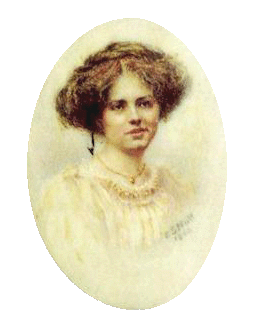
Elizabeth Styring Nutt
from a self-portrait circa 1910
Introduction:
of Four Seasonal Paintings of the North West Arm
an article by Joel Zemel with photography by David Middleton
ISBN #978-0-9684920-8-6
Page 2

Elizabeth Styring Nutt
from a self-portrait circa 1910
Introduction:
In July of 2009, I received an e-mail from one of my coffee klatch chums, Jane Risley. Apparently, the Senior Conservator at the Art Gallery of Nova Scotia (AGNS) was trying to get some feedback from former residents whose families lived near the North West Arm regarding possible settings for a series of oil paintings depicting the area in all four seasons. The artist, Elizabeth Styring Nutt (1870-1946), was a former principal of the Victoria School of Art and Design, later known as the Nova Scotia College of Art and Design (NSCAD).
Jane's family had lived near Horseshoe Island for many years. There had been some speculation that one of the paintings bore a resemblance to their property. However, because the area in the background did not match, Jane and her brother Robert, an avid photographer, agreed that the look of the paintings was not in keeping with that of Horseshoe Island.
Jane knew I loved mysteries, having just completed research and several web pages on an analysis of two photographs of the 1917 Halifax Explosion blast cloud. This challenge seemed fairly straightforward. Of course, they always do - in the beginning.
Elizabeth Nutt (1870-1946) was the principal of the Victoria School of Art, later the Nova Scotia College of Art and Design, for twenty-five years. Like her friend and predecessor at the college, Arthur Lismer (1885-1969) of the Canadian Group of Seven, she was an impressionist painter. Yet, to those familiar with the South End of Halifax, the scenarios depicted in her North West Arm paintings undoubtedly project a certain realism. Even though seventy-five years have passed and inevitable changes to the landscapes have taken place, these areas are still recognizable to some extent. With the exception of "Winter", the rocky coastline on the North West Arm shown in three of the paintings is only present on the shores of Point Pleasant Park beginning just off Chain Rock Drive in the South End of Halifax. In addition, the conifer-filled backdrops across the Arm are completely consistent with this area.
I decided to start with "Winter".
Jane's family had lived near Horseshoe Island for many years. There had been some speculation that one of the paintings bore a resemblance to their property. However, because the area in the background did not match, Jane and her brother Robert, an avid photographer, agreed that the look of the paintings was not in keeping with that of Horseshoe Island.
Jane knew I loved mysteries, having just completed research and several web pages on an analysis of two photographs of the 1917 Halifax Explosion blast cloud. This challenge seemed fairly straightforward. Of course, they always do - in the beginning.
Elizabeth Nutt (1870-1946) was the principal of the Victoria School of Art, later the Nova Scotia College of Art and Design, for twenty-five years. Like her friend and predecessor at the college, Arthur Lismer (1885-1969) of the Canadian Group of Seven, she was an impressionist painter. Yet, to those familiar with the South End of Halifax, the scenarios depicted in her North West Arm paintings undoubtedly project a certain realism. Even though seventy-five years have passed and inevitable changes to the landscapes have taken place, these areas are still recognizable to some extent. With the exception of "Winter", the rocky coastline on the North West Arm shown in three of the paintings is only present on the shores of Point Pleasant Park beginning just off Chain Rock Drive in the South End of Halifax. In addition, the conifer-filled backdrops across the Arm are completely consistent with this area.
I decided to start with "Winter".
Please note: At the time the images on this page were taken, the tide was on the way in.
At the time Elizabeth Nutt painted the four seasons on the North West Arm, there was not much in the way of land development along the shore just before Point Pleasant Park near Chain Rock Drive in the South End of Halifax. Today, all of this area is privately owned. The location for "Winter" (1927) would have been quite accessible back in the day and judging from the lay of the land in the painting, was somewhere to the West and slightly North of Point Pleasant Park. The images of the paintings Jane sent to me via e-mail were not of great quality, leaving much of the background detail difficult to make out. So, a trip to the Halifax Public Library appeared to be in order.
One of the librarians found a book with an excellent and detailed color plate of "Winter". She also produced some other books and several articles from the Chronicle Herald (included on this web page) as well as related articles on the Jollimore and Purcell ferry services that ran on the North West Arm throughout the years.
The prominent clear-cut area and the buildings in the painting made this location fairly easy to identify (or so I thought). One of the books I looked through, "Sketches & Traditions of the Northwest Arm" by John W. Regan (1908), had an interesting photo of Jollimore Settlement (also Jollimore or Arm Village), an area dotted with numerous buildings. The area was a well known as a summer vacation destination for the rich and famous. By the time 1927 rolled around, the village probably would not have grown much larger than when this photograph was taken. Jollimore Settlement appeared to be a good first choice as the backdrop for "Winter".
I also referred to a 1916 map of Halifax that was used for the Royal Society of Canada report on the Halifax Explosion. Inglis Street extends in a theoretical broken line to the shore, Jollimore Settlement sits directly across the North West Arm from this spot.
Whether or not Inglis Street was the actual setting for "Winter", I decided to leave this painting temporarily to pursue an idea about which I felt more confident - that "Spring" was painted from a vantage point in or very close to Point Pleasant Park.
At the time Elizabeth Nutt painted the four seasons on the North West Arm, there was not much in the way of land development along the shore just before Point Pleasant Park near Chain Rock Drive in the South End of Halifax. Today, all of this area is privately owned. The location for "Winter" (1927) would have been quite accessible back in the day and judging from the lay of the land in the painting, was somewhere to the West and slightly North of Point Pleasant Park. The images of the paintings Jane sent to me via e-mail were not of great quality, leaving much of the background detail difficult to make out. So, a trip to the Halifax Public Library appeared to be in order.
One of the librarians found a book with an excellent and detailed color plate of "Winter". She also produced some other books and several articles from the Chronicle Herald (included on this web page) as well as related articles on the Jollimore and Purcell ferry services that ran on the North West Arm throughout the years.
The prominent clear-cut area and the buildings in the painting made this location fairly easy to identify (or so I thought). One of the books I looked through, "Sketches & Traditions of the Northwest Arm" by John W. Regan (1908), had an interesting photo of Jollimore Settlement (also Jollimore or Arm Village), an area dotted with numerous buildings. The area was a well known as a summer vacation destination for the rich and famous. By the time 1927 rolled around, the village probably would not have grown much larger than when this photograph was taken. Jollimore Settlement appeared to be a good first choice as the backdrop for "Winter".
I also referred to a 1916 map of Halifax that was used for the Royal Society of Canada report on the Halifax Explosion. Inglis Street extends in a theoretical broken line to the shore, Jollimore Settlement sits directly across the North West Arm from this spot.
Whether or not Inglis Street was the actual setting for "Winter", I decided to leave this painting temporarily to pursue an idea about which I felt more confident - that "Spring" was painted from a vantage point in or very close to Point Pleasant Park.
Even before I started looking, there appeared to be a general consensus that this scene was located near the bottom of Chain Rock Drives. On the 1916 map, this very area is listed as a public bath. One drizzly morning, I walked down the paths at Point Pleasant Park to the corner of Serpentine and Cable Roads, the site of the very necessary Balmoral sewage pumping station. I traversed the rocks while avoiding all the floatables and made my way onto the small beach below. Ms Nutt's painting and the view of Purcell's Cove across the Arm today is undeniable. Looking to my left, I noticed an outcropping of rocks that bore a definite resemblance to the painting. I decided to head Northwest along the shore so as to gain the perspective of the painting.
I approached a group of large rocks that looked like those in the foreground of the painting. It was necessary to climb over them and up onto a recently built stone wall in order to achieve some height. Unfortunately I was now on what appeared to be private property. There were two wharves close by and I would have had to climb over other obstacles to gain access. As this was just a reconnaissance mission, I would come back later to get permission to go on the wharves when I was ready to take photographs. As I stood on the wall looking out towards the ocean, I had little doubt that this was indeed the location of Elizabeth Nutt's "Spring". I thought how appalled she would be to see the decrepit appearance of the small beach and its surroundings although I'm also certain she would be gratified it was still there at all and not the unfortunate victim of complete over-development.
These days, there are trees blocking the view of land's end in the distance and it was very difficult to gain the proper perspective. Also, we could not get back far enough or low enough because the land immediately behind the shot is private property and built up with a stone wall and a couple of wharves. We did the best we could under the circumstances.
I approached a group of large rocks that looked like those in the foreground of the painting. It was necessary to climb over them and up onto a recently built stone wall in order to achieve some height. Unfortunately I was now on what appeared to be private property. There were two wharves close by and I would have had to climb over other obstacles to gain access. As this was just a reconnaissance mission, I would come back later to get permission to go on the wharves when I was ready to take photographs. As I stood on the wall looking out towards the ocean, I had little doubt that this was indeed the location of Elizabeth Nutt's "Spring". I thought how appalled she would be to see the decrepit appearance of the small beach and its surroundings although I'm also certain she would be gratified it was still there at all and not the unfortunate victim of complete over-development.
These days, there are trees blocking the view of land's end in the distance and it was very difficult to gain the proper perspective. Also, we could not get back far enough or low enough because the land immediately behind the shot is private property and built up with a stone wall and a couple of wharves. We did the best we could under the circumstances.
Below (Fig. 1a & 1b) - The view: 2009 and 1927.
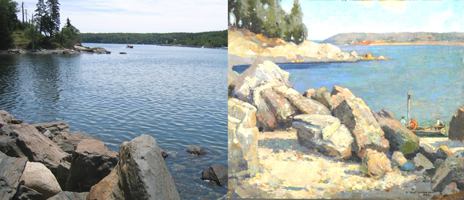

Finding the location for Autumn proved to be more of a challenge. The day I chose for my search was bright and sunny, not unlike the day in the painting itself. The consensus was that this scene was painted near the old Purcell's Cove ferry wharf. However, this location seemed highly unlikely because of the look of the land across the Arm.
As I walked from the "Spring" location, I found another locale just on the other side of the rocks that was close to the water but did not resemble anything in the paintings. Nearby, there was another well-worn path to the water that seemed to have possibilities. This feeling was instinctive because, at first glance, the similarities to the painting were superficial, at best. From a high position, there was a similar view of the path but the area had changed greatly in seventy years. The upper section of the path had all but disappeared having been overrun by vegetation. Most of the trees, as in the painting, are not conifers. The blocks of cut granite to the right foreground in the painting were still visible. (below: Fig. 2a & 2b)
A semblance of the path still exists today although it proceeds in a different direction than the one in the painting. The view of the Arm and the land in the background (Fig.2d) is completely obfuscated by trees and branches. The angle of the granite block wall is different as well. Other than the possibility that the blocks were re-arranged at some point by the city, Ms Nutt most likely changed the angles and perspectives for compositional purposes.
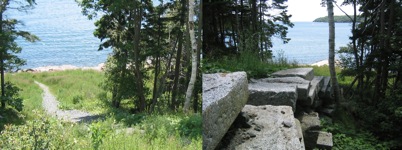
As I walked from the "Spring" location, I found another locale just on the other side of the rocks that was close to the water but did not resemble anything in the paintings. Nearby, there was another well-worn path to the water that seemed to have possibilities. This feeling was instinctive because, at first glance, the similarities to the painting were superficial, at best. From a high position, there was a similar view of the path but the area had changed greatly in seventy years. The upper section of the path had all but disappeared having been overrun by vegetation. Most of the trees, as in the painting, are not conifers. The blocks of cut granite to the right foreground in the painting were still visible. (below: Fig. 2a & 2b)
A semblance of the path still exists today although it proceeds in a different direction than the one in the painting. The view of the Arm and the land in the background (Fig.2d) is completely obfuscated by trees and branches. The angle of the granite block wall is different as well. Other than the possibility that the blocks were re-arranged at some point by the city, Ms Nutt most likely changed the angles and perspectives for compositional purposes.

I walked further down the path towards a concrete wharf. As I approached the shoreline, sure enough, there was the view of the Arm almost exactly as portrayed in the painting (see Fig 2c below). Regardless of the incongruities, this was the only place in Point Pleasant Park where all major elements of the painting existed together. This setting is only a few feet off one of the the main pathways through the park. I was satisfied that this was indeed the location for "Autumn".
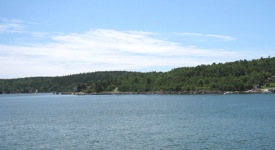
Below (Fig. 2d & 2e): The view: 2009 and 1930
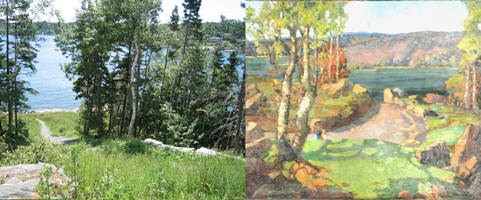

Below (Fig. 2d & 2e): The view: 2009 and 1930

One has to keep in mind that this stretch of rocky shore along the Arm only extends for a half-mile at most before it turns to the East - a very limited distance - leaving very limited choices for the locations of these paintings. I stepped onto the short concrete wharf. To my left I could see the old Purcell's cove ferry wharf and beyond that to where the land turns Eastward. To my right, a couple about one hundred feet back but hidden by rocks and trees, was the setting for "Spring". As I looked around, it seemed there was no place left that could be a possible setting for "Summer". Maybe, as mentioned in the 1980 Herald article, one of the paintings could have been done looking toward the Halifax side; though early on; numerous visits to Google Earth had put the kibosh to this idea.
In my search for clues the week before, I came across a detailed 1931 aerial photograph of the North West Arm (Fig. 3a) in a book about the history of South End Halifax by Peter McGuigan. The photo was credited to Saint Mary's University. I had visited the Patrick Power Library and was kindly given a copy of the photo by Hansel Cook, a librarian there. The photograph gave a clear indication of how accessible this whole area was when Elizabeth Nutt worked on her paintings.
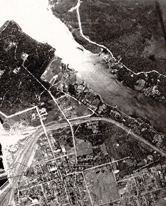
In my search for clues the week before, I came across a detailed 1931 aerial photograph of the North West Arm (Fig. 3a) in a book about the history of South End Halifax by Peter McGuigan. The photo was credited to Saint Mary's University. I had visited the Patrick Power Library and was kindly given a copy of the photo by Hansel Cook, a librarian there. The photograph gave a clear indication of how accessible this whole area was when Elizabeth Nutt worked on her paintings.

As I stood on the concrete wharf, the idea occurred to me that the area I was looking for may be between the "Spring" and "Autumn" locales. Although it seemed a long shot, I maneuvered my way over and around the rocks and was surprised to find yet another beach area. However, this could not have been the setting for "Summer" - it was much too small. I then noticed two large weathered wooden beams with rusted metal bolted plates lying on the ground to my left - possibly the remnants of a small utility shack. Was it possible that these were the remnants of the wooden shed in the painting?
The land behind the small beach section was several feet higher with a significant drop off. There wasn't much in the way of decent toeholds but I still managed to huff and puff my way to the top. When I turned around to look out at the Arm, the vista was the one I had been searching for. This view was also almost completely blocked by trees and overgrown vegetation. The area was no longer cleared and trimmed on a regular basis as in many years gone by. Ms Nutt may have taken a bit of artistic license with the rock formations and limited perspective but the large boulder sitting prominently in the foreground was present and the background across the Arm looked correct as well.
Ms Nutt made this somewhat small vista larger than life in her painting but it certainly appeared to be the setting for "Summer". Unfortunately, the view is now so obscured by trees and vegetation, it's difficult to take a satisfactory photograph. Later on, I found a small relatively unused side path again, overrun with vegetation. In 1926, however, Ms Nutt would have had no problem whatsoever accessing the location for her painting.
One thing that initially made me think this area may not be the location for "Summer" was the absence of the trees sitting on the tiny bit of land behind the shed. Today, there is little evidence left to suggest it was ever there. However, such a strip of land is visible in the close-up below from the 1931 aerial photograph (Fig. 3b). Other than artistic license or topsoil erosion, one can only speculate as to reasons for the foliage's disappearance.
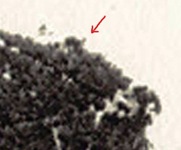
The land behind the small beach section was several feet higher with a significant drop off. There wasn't much in the way of decent toeholds but I still managed to huff and puff my way to the top. When I turned around to look out at the Arm, the vista was the one I had been searching for. This view was also almost completely blocked by trees and overgrown vegetation. The area was no longer cleared and trimmed on a regular basis as in many years gone by. Ms Nutt may have taken a bit of artistic license with the rock formations and limited perspective but the large boulder sitting prominently in the foreground was present and the background across the Arm looked correct as well.
Ms Nutt made this somewhat small vista larger than life in her painting but it certainly appeared to be the setting for "Summer". Unfortunately, the view is now so obscured by trees and vegetation, it's difficult to take a satisfactory photograph. Later on, I found a small relatively unused side path again, overrun with vegetation. In 1926, however, Ms Nutt would have had no problem whatsoever accessing the location for her painting.
One thing that initially made me think this area may not be the location for "Summer" was the absence of the trees sitting on the tiny bit of land behind the shed. Today, there is little evidence left to suggest it was ever there. However, such a strip of land is visible in the close-up below from the 1931 aerial photograph (Fig. 3b). Other than artistic license or topsoil erosion, one can only speculate as to reasons for the foliage's disappearance.

The photos below (Fig. 3c, 3d & 3e) show an unobstructed view along the small beach area looking West towards the Royal Nova Scotia Yacht Squadron/Saraguay Club (note the little tree from the "Spring" location), a close-up of beams, possibly from the old shed and a look across the Arm with some larger rocks in the foreground.

Below (Fig. 3f & 3g) - The view: 2009 (as best as we could get it) and 1926.
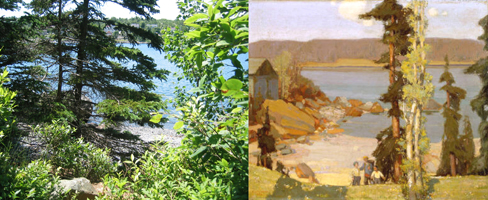

Below (Fig. 3f & 3g) - The view: 2009 (as best as we could get it) and 1926.

Back to "Winter": The more I thought about the end of Inglis Street looking across to Jollimore Settlement as a location for "Winter", the more it didn't add up. One problem was that the buildings appeared more sparse in the painting than in the photo of Jollimore Settlement before 1908. A larger issue with this choice was that it did not fit the pattern Ms Nutt established for her series of paintings. Why would she paint three pictures from the area of Point Pleasant Park but not the fourth? From an artistic and thematic point of view, it hardly made sense. I decided to recheck the 1931 aerial photograph of the North west Arm and sure enough - upon examination, one other option arose. In all likelihood, without the assistance of this map, the solution would not have been as easily apparent.
The photograph below (Fig.4) shows a pathway, a mere stone's throw from the "Spring" painting's location, which extends from Chain Rock Drive to the shore and faces the area across the Arm where the Royal Nova Scotia Yacht Squadron is located today.
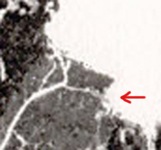
The photograph below (Fig.4) shows a pathway, a mere stone's throw from the "Spring" painting's location, which extends from Chain Rock Drive to the shore and faces the area across the Arm where the Royal Nova Scotia Yacht Squadron is located today.

The Saraguay Club itself is out of frame in both the painting and the photograph. RNSYS relocated to the North West Arm in 1966 to make way for the new container terminal. The 1916 map of Halifax refers to this area as the Saraguay Club. Apparently, in 1927, there were still only a small number of structures on the land. Also, the width of the clear cut in the photograph is a very close match to the painting. There are no conifers on the Halifax side and the trees in the immediate foreground are quite sparse. A wide path is indicated between these trees and a number of small fence posts to the right leading down to the shore. Even the tiny cove across the Arm, visible in the 1931 aerial photograph, can clearly be seen in the upper left section of the painting. The old line from the original clear-cut is still visible in our photograph below. This is most likely the setting for "Winter".
Please note: This photograph was taken slightly West of the actual location. The owners of the residence were kind enough to let us work from their dock. Unfortunately, the distant, rolling hills as seen in the background of the painting are not visible. Logistically, we could not achieve the proper elevation and still get the shot.
Please note: This photograph was taken slightly West of the actual location. The owners of the residence were kind enough to let us work from their dock. Unfortunately, the distant, rolling hills as seen in the background of the painting are not visible. Logistically, we could not achieve the proper elevation and still get the shot.
Below (Fig. 4a & 4b) - The view: 2009 and 1927.
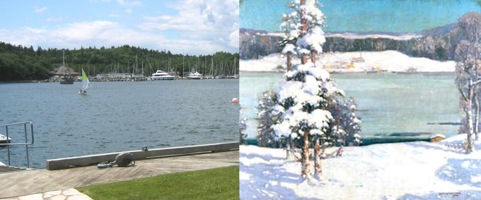

Closing Notes:
Considering Elizabeth Nutt's strict and somewhat traditional background regarding her learning her craft and from what I had read about her, I was hesitant to embrace the idea that she would have taken great leaps of artistic license with her work - that is, as far as the views are concerned. This notion helped to focus my search as I attempted to visualize potential locations almost simultaneously in past and present time frames. As the photographs show, three of these locations have undergone tremendous changes over the years rendering them almost unrecognizable. After the settings for the four seasons series had revealed themselves, I realized Ms Nutt, notwithstanding several minor inconsistencies, had stayed fairly true to form with the views themselves. She painted with a sense of realism but in her own wonderfully impressionistic, creative and appealing style.
However, there is one major undeniable aspect of artistic license Ms Nutt chose to incorporate into each of her four paintings that left no doubt in my mind she also had a playful sense of humour. All of the human figures are depicted in miniature. Along with the boat in "Spring", the granite wall in "Autumn" and the sled in "Winter", her human figures were painted much smaller than life size to make the vistas appear more expansive than they really were.
The actual length of the shore front in "Summer" ( see Fig. 3c), is about twenty-five feet across, if that. In the painting, it appears nearly four times that length. As a filmmaker with over twenty years experience, I certainly have an appreciation for the art of illusion. If anyone not at all familiar with the area were to take the size of Ms Nutt's human figures at face value, then finding the locations of her paintings would be next to impossible.
Please note the following illustrations: Click on the expandable window button (left). Then click on the thumbnail below (left) for a larger image (Fig. 4c). Look at the size of the rocks that appear in the foreground of the painting relative to my size (I'm standing about eight or ten feet away). Then compare this to the size of the boat in "Spring". Ms Nutt's position may have been slightly to my right where the wooden deck is now. Fig. 4d also illustrates that the human figures in "Winter" are miniscule in comparison to their actual surroundings.
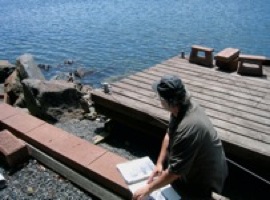
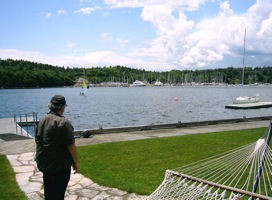
Considering Elizabeth Nutt's strict and somewhat traditional background regarding her learning her craft and from what I had read about her, I was hesitant to embrace the idea that she would have taken great leaps of artistic license with her work - that is, as far as the views are concerned. This notion helped to focus my search as I attempted to visualize potential locations almost simultaneously in past and present time frames. As the photographs show, three of these locations have undergone tremendous changes over the years rendering them almost unrecognizable. After the settings for the four seasons series had revealed themselves, I realized Ms Nutt, notwithstanding several minor inconsistencies, had stayed fairly true to form with the views themselves. She painted with a sense of realism but in her own wonderfully impressionistic, creative and appealing style.
However, there is one major undeniable aspect of artistic license Ms Nutt chose to incorporate into each of her four paintings that left no doubt in my mind she also had a playful sense of humour. All of the human figures are depicted in miniature. Along with the boat in "Spring", the granite wall in "Autumn" and the sled in "Winter", her human figures were painted much smaller than life size to make the vistas appear more expansive than they really were.
The actual length of the shore front in "Summer" ( see Fig. 3c), is about twenty-five feet across, if that. In the painting, it appears nearly four times that length. As a filmmaker with over twenty years experience, I certainly have an appreciation for the art of illusion. If anyone not at all familiar with the area were to take the size of Ms Nutt's human figures at face value, then finding the locations of her paintings would be next to impossible.
Please note the following illustrations: Click on the expandable window button (left). Then click on the thumbnail below (left) for a larger image (Fig. 4c). Look at the size of the rocks that appear in the foreground of the painting relative to my size (I'm standing about eight or ten feet away). Then compare this to the size of the boat in "Spring". Ms Nutt's position may have been slightly to my right where the wooden deck is now. Fig. 4d also illustrates that the human figures in "Winter" are miniscule in comparison to their actual surroundings.


Even though the options were very few to begin with, it was still fun tracking down these locations. My efforts consisted of a couple of two to three hours treks around one small section of Point Pleasant Park and nearby Chain Rock Drive.
I am confident that these are the locations from which the artist composed her series of paintings depicting the four seasons on the North West Arm. All four views were painted in the vicinity of Point Pleasant Park within a range of approximately 200 yards. At the time she was doing this work, Ms Nutt resided in the Council of Women's House (Halifax Local Council of Women), 163 Young Avenue, which is in very close proximity to Point Pleasant Park. Her residence was listed at the same address in the 1926 and 1933 Halifax Phone Books. It makes perfect sense that she followed the pragmatic and sensible path of least resistance in her artistic endeavours.
The close-up photograph below (Fig. 4d & 4e) shows the approximate locations (view: North to South + or -) where Elizabeth Styring Nutt painted her four season series (red dots). The photograph on the right shows these areas as they are today (angle and size of the photographs vary slightly).
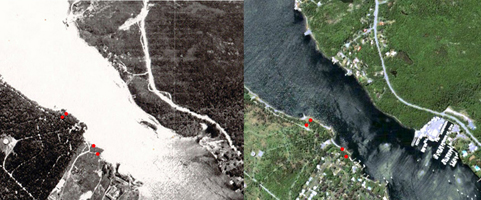
---
I am confident that these are the locations from which the artist composed her series of paintings depicting the four seasons on the North West Arm. All four views were painted in the vicinity of Point Pleasant Park within a range of approximately 200 yards. At the time she was doing this work, Ms Nutt resided in the Council of Women's House (Halifax Local Council of Women), 163 Young Avenue, which is in very close proximity to Point Pleasant Park. Her residence was listed at the same address in the 1926 and 1933 Halifax Phone Books. It makes perfect sense that she followed the pragmatic and sensible path of least resistance in her artistic endeavours.
The close-up photograph below (Fig. 4d & 4e) shows the approximate locations (view: North to South + or -) where Elizabeth Styring Nutt painted her four season series (red dots). The photograph on the right shows these areas as they are today (angle and size of the photographs vary slightly).

---
Click here for a U.K. website that provides detailed background information on Elizabeth Nutt and her family.
Click here for additional information on Elizabeth Styring Nutt from The Canadian Women Artists History Initiative.
Three articles from the Chronicle Herald regarding a 1980 exhibition of Elizabeth Nutt paintings at Dalhousie Art Gallery (article 1, article 2, article 3).
A 1989 article on the dedication, in Elizabeth Nutt's memory, of The City of Halifax Gallery at the Art Gallery of Nova Scotia. The AGNS is planning a new exhibition of the artist's work in the near future.
Reference: Sketches and Traditions of the Northwest Arm (1908) by John W. Regan.
Other paintings by Elizabeth Nutt:
Click here for additional information on Elizabeth Styring Nutt from The Canadian Women Artists History Initiative.
Three articles from the Chronicle Herald regarding a 1980 exhibition of Elizabeth Nutt paintings at Dalhousie Art Gallery (article 1, article 2, article 3).
A 1989 article on the dedication, in Elizabeth Nutt's memory, of The City of Halifax Gallery at the Art Gallery of Nova Scotia. The AGNS is planning a new exhibition of the artist's work in the near future.
Reference: Sketches and Traditions of the Northwest Arm (1908) by John W. Regan.
Other paintings by Elizabeth Nutt:
Where Sunshine Falls (1924), A Moorland Stream (1932), The Old Cottage, South Yorkshire (1930)
/wheresunshinefallssm.jpg)
/amoorlandstreamsm.jpg)
/theoldcottagesm.jpg)
/wheresunshinefallssm.jpg)
/amoorlandstreamsm.jpg)
/theoldcottagesm.jpg)
Regarding The Old Cottage, South Yorkshire, Elizabeth Styring Nutt "maintained strong connections to English
academic traditions. She painted 'en plein air' and rarely
referred to preliminary sketches." Miss Nutt "used a Square -
Brush technique of her own design to lay down undiluted
colours on canvas, with a broad un-tapered brush. Nutt's
work shows a strong Newlyn influence, very much in the
manner of an early Stanhope Forbes." "The canvas was exhibited at the Royal Canadian Academy of Arts in 1928, although it is dated 1930." - from the 'thomas fine arts' catalogue.
The Old Cottage St. Faith's near Norwich (1930), Red Maple, North West Arm, Halifax,
Fishing Boat in a Mountainous Moonlit Estuary (signed and dated 1931)
/theoldcottage2sm.jpg)
/redmaplesm.jpg)
/fishingboatsm.jpg)
Photo portrait of Elizabeth Nutt, circa 1930. Courtesy of NSARM.
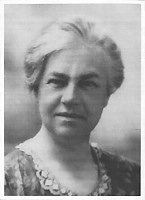
Fishing Boat in a Mountainous Moonlit Estuary (signed and dated 1931)
/theoldcottage2sm.jpg)
/redmaplesm.jpg)
/fishingboatsm.jpg)
Photo portrait of Elizabeth Nutt, circa 1930. Courtesy of NSARM.

Below: Canadian Authors Association Annual Convention, July 6, 1939 - party at Haliburton House. Elizabeth S. Nutt is standing fourth from right. Photo courtesy of NSARM.
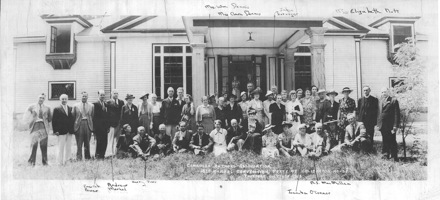
---
Following the restoration of "Autumn" at the Art Gallery of Nova Scotia,
an exhibition of the artist's work is planned for Spring of 2010.
In Canada, images of the work of Elizabeth Styring Nutt are in the Public Domain.
Information from the National Gallery of Canada in Ottawa, Ontario.
The paintings by Elizabeth Nutt displayed on this website are not high resolution
images and merely represent an idea of the quality of her actual work.
Many thanks to David Middleton for the great photographs.
Photographs © 2009 David Middleton. All rights reserved.
Page 1

---
Following the restoration of "Autumn" at the Art Gallery of Nova Scotia,
an exhibition of the artist's work is planned for Spring of 2010.
In Canada, images of the work of Elizabeth Styring Nutt are in the Public Domain.
Information from the National Gallery of Canada in Ottawa, Ontario.
The paintings by Elizabeth Nutt displayed on this website are not high resolution
images and merely represent an idea of the quality of her actual work.
Many thanks to David Middleton for the great photographs.
Photographs © 2009 David Middleton. All rights reserved.
Page 1
| Main | Jazz Guitar | Shakespeare Sonnets | About SVP | Halifax Explosion | Links | SVP News | Contact SVP |
![]() 2009 SVP Productions. All text protected. All rights reserved.
2009 SVP Productions. All text protected. All rights reserved.